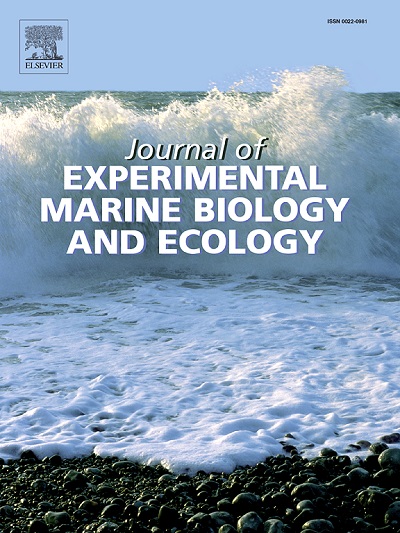Kelp-bed dynamics across scales: Expanding distributional analysis capacity with spatial pattern metrics and modelling
IF 1.8
3区 生物学
Q3 ECOLOGY
Journal of Experimental Marine Biology and Ecology
Pub Date : 2025-01-01
DOI:10.1016/j.jembe.2024.152080
引用次数: 0
Abstract
Spatial pattern metrics are used to investigate the links between a species' distributional patterns and underlying ecological drivers. These metrics, in combination with remotely acquired imagery, offer a novel approach for the study of kelp bed-urchin barren systems and enable the study of fully submerged kelp distribution at broad spatial scales (km2) difficult to achieve through traditional scuba-based methods. This study uses aerial imagery of 2.85 km2 of shallow (<7 m deep) seabed around five islands in the Mingan Archipelago (northern Gulf of St. Lawrence, Canada) to (1) quantify kelp distribution patterns using spatial pattern metrics at large, intermediate, and small spatial scales and (2) examine correlations between kelp presence and physical and biological variables over a broad spatial scale. Imagery was classified visually and divided into two benthic classes: kelp and non-kelp. Variability in spatial pattern metrics and kelp coverage across spatial scales indicated that kelp distribution is not uniform among islands, suggesting that the spatial extent over which observations are obtained strongly influences the patterns detected. Kelp covered 62 % of the entire study area but with substantial variation (46 % to 87 %) among islands. Kelp and non-kelp patches varied in size from 225 to 891,225 m2, while exhibiting considerable variation in geometric complexity. Over 80 % of the kelp patches were relatively small (<1350 m2), although the fewer, larger patches contained most (98 %) of the kelp-covered seabed and were located in shallower water, near the coastline. Both the kelp and non-kelp benthic classes were highly aggregated as suggested by clumpiness indices of 0.67 and 0.59, respectively. Modelling results showed that increasing depth, urchin density, and relative exposure to waves independently led to a decrease in kelp presence, with depth having the strongest correlation, followed by urchin density and relative exposure. This study expands knowledge of kelp distribution patterns at broad spatial scales largely unexplored for fully submerged species and is a step forward towards a comprehensive understanding of scale-dependent processes regulating their distribution.
跨尺度海带床动力学:扩展分布分析能力与空间模式度量和建模
空间格局度量用于研究物种分布格局与潜在生态驱动因素之间的联系。这些指标与远程获取的图像相结合,为海带床海胆贫瘠系统的研究提供了一种新的方法,并使通过传统的基于水肺的方法难以实现的大空间尺度(km2)的完全淹没海带分布研究成为可能。本研究使用了明安群岛(加拿大圣劳伦斯湾北部)五个岛屿周围2.85平方公里的浅(<;7米深)海底的航空图像,以:(1)在大、中、小空间尺度上使用空间格局指标量化海带分布模式;(2)在广泛的空间尺度上检查海带存在与物理和生物变量之间的相关性。对图像进行视觉分类,并将其分为两类:海带和非海带。空间格局指标和海带覆盖在空间尺度上的可变性表明,海带在岛屿之间的分布并不均匀,这表明获得观测的空间范围对探测到的格局有很大影响。海带覆盖了整个研究区域的62%,但在岛屿之间差异很大(46%至87%)。海带和非海带斑块的大小从225到891,225 m2不等,而几何复杂性变化很大。超过80%的海带斑块相对较小(1350平方米),尽管较少,较大的斑块包含了大部分(98%)海带覆盖的海床,并且位于较浅的水域,靠近海岸线。块状指数分别为0.67和0.59,表明海带类和非海带类底栖动物聚集程度较高。建模结果表明,增加深度、海胆密度和相对暴露于海浪的程度分别导致海带数量的减少,其中深度的相关性最强,其次是海胆密度和相对暴露。这项研究扩大了对海带分布模式的认识,在广泛的空间尺度上对完全淹没的海带物种进行了很大程度上的探索,并朝着全面理解调节其分布的尺度依赖过程迈出了一步。
本文章由计算机程序翻译,如有差异,请以英文原文为准。
求助全文
约1分钟内获得全文
求助全文
来源期刊
CiteScore
4.30
自引率
0.00%
发文量
98
审稿时长
14 weeks
期刊介绍:
The Journal of Experimental Marine Biology and Ecology provides a forum for experimental ecological research on marine organisms in relation to their environment. Topic areas include studies that focus on biochemistry, physiology, behavior, genetics, and ecological theory. The main emphasis of the Journal lies in hypothesis driven experimental work, both from the laboratory and the field. Natural experiments or descriptive studies that elucidate fundamental ecological processes are welcome. Submissions should have a broad ecological framework beyond the specific study organism or geographic region.
Short communications that highlight emerging issues and exciting discoveries within five printed pages will receive a rapid turnaround. Papers describing important new analytical, computational, experimental and theoretical techniques and methods are encouraged and will be highlighted as Methodological Advances. We welcome proposals for Review Papers synthesizing a specific field within marine ecology. Finally, the journal aims to publish Special Issues at regular intervals synthesizing a particular field of marine science. All printed papers undergo a peer review process before being accepted and will receive a first decision within three months.

 求助内容:
求助内容: 应助结果提醒方式:
应助结果提醒方式:


